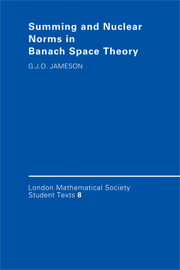Book contents
- Frontmatter
- Contents
- Introduction
- 0 Banach space background
- 1 Finite rank operators: trace and 1-nuclear norm
- 2 Finite sequences of elements: the quantities μ1, μ2
- 3 The summing norms
- 4 Other nuclear norms: duality with the summing norms
- 5 Pietsch's theorem and its applications
- 6 Averaging; type 2 and cotype 2 constants
- 7 More averaging: Khinchin's inequality and related results
- 8 Integral methods; Gaussian averaging
- 9 2-dominated spaces
- 10 Grothendieck's inequality
- 11 The interpolation method for Grothendieck-type theorems
- 12 Results connected with the basis constant
- 13 Estimation of summing norms using a restricted number of elements
- 14 Piseer's theorem for π2, 1
- 15 Tensor products of operators
- 16 Trace duality revisited: integral norms
- 17 Applications of local reflexivity
- 18 Cone-summing norms
- References
- List of symbols
- Index
10 - Grothendieck's inequality
Published online by Cambridge University Press: 12 October 2009
- Frontmatter
- Contents
- Introduction
- 0 Banach space background
- 1 Finite rank operators: trace and 1-nuclear norm
- 2 Finite sequences of elements: the quantities μ1, μ2
- 3 The summing norms
- 4 Other nuclear norms: duality with the summing norms
- 5 Pietsch's theorem and its applications
- 6 Averaging; type 2 and cotype 2 constants
- 7 More averaging: Khinchin's inequality and related results
- 8 Integral methods; Gaussian averaging
- 9 2-dominated spaces
- 10 Grothendieck's inequality
- 11 The interpolation method for Grothendieck-type theorems
- 12 Results connected with the basis constant
- 13 Estimation of summing norms using a restricted number of elements
- 14 Piseer's theorem for π2, 1
- 15 Tensor products of operators
- 16 Trace duality revisited: integral norms
- 17 Applications of local reflexivity
- 18 Cone-summing norms
- References
- List of symbols
- Index
Summary
Introduction
The result known as Grothendieck's inequality is coming to be recognized as one of the really major theorems of Banach space theory. It first appeared in Grothendieck (1956) under the title “the Fundamental theorem of the metric theory of tensor products” (as we have seen, a number of the other results considered in this book can be traced to the same memoir). In fact, the theorem admits a remarkable number of equivalent formulations, expressed variously in terms of summing norms, bilinear forms and tensor products. One version says that J?1 has a property rather stronger than being 2-dominated. Some of these formulations were given by Grothendieck himself, others by later writers. A particularly elementary version was given by Lindenstrauss & Pelczynski (1968); this served to make the theorem much better known and understood by mathematicians generally.
The theorem has many applications, both within Banach space theory and in other areas, notably harmonic analysis (we cannot attempt to do justice to these in this book). Also, there is by now a repertoire of alternative proofs that must have few parallels in Mathematics. Despite this, the exact determination of the constant appearing in the inequality remains an unsolved problem. There are actually two separate problems, for the real and complex cases respectively.
In this section, we start with the Lindenstrauss-Pelczynski formulation, and give a version of the proof, due to Krivine (1979), that yields the best current estimate of the constant in the real case.
- Type
- Chapter
- Information
- Summing and Nuclear Norms in Banach Space Theory , pp. 104 - 117Publisher: Cambridge University PressPrint publication year: 1987



